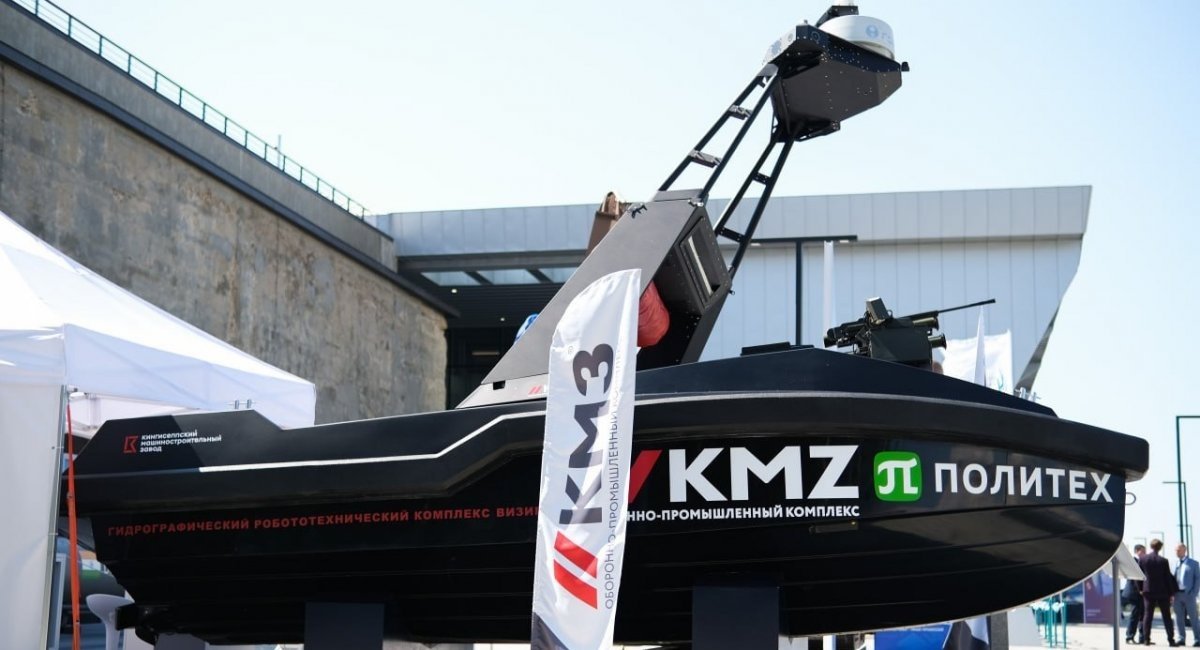As Ukraine continues to launch sea drone attacks on Russian Black Sea Fleet vessels, Russia has announced that it will receive its marine drone boats and deploy them against Ukraine for testing by the end of this year.
China’s Hypersonic Missile “Shoots Down” US B-21 Stealth Bomber In Wargame Simulations, Scientists Claim
Mikhail Danilenko, Managing Director of KMZ Holding (Kingisepp Machine-Building Plant), told RIA Novosti in an interview that the Russian Ministry of Defense (RuMoD) will receive the first Russian marine drones by the end of the year, following which they will be tested in the special operation zone.
“The Ministry of Defense has already agreed to deliver the first ten units, which we must send by the end of the year. This will be the first experimental party that will be tested in the SVO zone,” the MD reportedly told the Russian publication.
Danilenko said crewless boats that are set for induction against Ukraine can go over 200 kilometers at a speed of 80 kilometers per hour and can carry bombs weighing up to 600 kilograms.
KMZ has reportedly specified that the Russian military will be free to choose what weaponry to equip on the drone boats. More importantly, it said that the company can transform the marine drones into naval kamikaze drones, for which work has been underway for a while.
According to reports, KMZ is currently in talks with the military about possible naval drone serial delivery. This initial batch’s test outcomes will determine the final choice for serial production. KMZ Holding specializes in the production of boats for Russian law enforcement agencies.
KMZ unveiled a multifunctional unmanned surface vehicle (USV) based on the “Vizir” platform at the Army Forum 2023 held in August this year.

At the time, Danilenko said, “For the tasks of a crewless strike boat, it is possible to make a version with an electric drive, including the main engine and batteries, making it possible to move slowly, saving energy. It will be a hybrid engine. As a weapon against, for example, drones, it can be equipped with a large-caliber machine gun and light missiles.”
The company also displayed the GRK 700 Vizir hydrographic boat, designed for surveying coastal zones and seabeds, at the Army Forum exhibition. It can transport sonar equipment and echo sounders for area surveys. Danilenko said up to six boats can be connected simultaneously using one control panel.
Danilenko stated that the Vizir can use rockets, heavy machine guns, electronic warfare systems, and netting against aircraft to neutralize targets if enemy sea-based drones are intercepted. In addition, the ship can send out its drone and move to within visual range of a target.
Shortly after these cutting-edge drone boats were unveiled, Ukrainian media reported that the invention merited considerable attention owing to the threat it would pose to the Ukrainian military in the Black Sea. Military experts warned that introducing marine boats would be dangerous since they could be mass-produced, unlike the big Russian battleships.
These drone boats can be transformed into kamikaze drones and give the Russians an opportunity to strike civilian vessels entering or leaving Ukrainian ports. Ukrainian President Volodymyr Zelensky recently warned that Ukraine needs more air defenses to protect its grain export routes and regions bordering Russia. Russia’s introduction of marine boats by the end of this year would likely exacerbate Ukraine’s woes.
Ukraine has extensively deployed kamikaze naval drone boats to carry out some very high-profile attacks on the Russian Black Sea Fleet (BSF) vessels and seriously damaging them. Military analysts have observed that Ukraine has managed to wreak havoc on the Russian Navy despite not having a proper naval force of its own.
Ukraine Threatens Russian BSF With Sea Drones
Ukraine has been able to neutralize the advantages of the far more potent Russian navy thanks to its use of unmanned maritime drones, expanding stockpile of long-range anti-ship missiles, vital surveillance from Western allies, and focused attacks by its air force and special operations forces.
Although missile strikes have long been an object of discussion, Ukraine’s unmanned surface vessels have also assumed prominence in recent months with Kyiv’s offensive on the seas where it seeks to dislodge Russia – especially from the Sea of Azov, a body of water connected to the Black Sea by the narrow Strait of Kerch.
Ukraine has adopted a tactic during the conflict that involves using “kamikaze” unmanned surface vehicles (USVs) that are cleverly fitted with explosive payloads to render Russian vessels immobile. These USVs are maneuvered across long distances and purposefully aimed toward their targets to cause a tremendous explosion upon contact.
These USVs are believed to operate remotely thanks to a satellite link that has been improved to increase its operational range.
A critical attack involving USVs occurred on October 29, 2022, when Ukrainian naval drones struck Russia’s Black Sea Fleet facility in the port of Sevastopol. While the attack did not result in vessels sinking, Moscow was prompted to enhance its defensive capabilities in Crimean ports, and it also deterred them from sending warships out of the protective umbrella provided by the port’s defenses. These attacks have seen an uptick in recent months.

On August 4, the Russian Merchant Tanker Sig was targeted and rendered inoperable by a suicide naval drone. The assault reportedly occurred near the Russian port of Novorossiysk, which is a central hub for Russian exports. A separate incident occurred on August 2, wherein an attempted attack on Russian patrol boats, likely accompanying the merchant vessel Sparta IV, was thwarted.
In the aftermath of these attacks, the UK Defense Ministry said the attacks illustrate that USVs are progressively becoming a significant aspect of contemporary naval warfare, capable of being directed at “the weakest links of Russia’s sea supply lanes.”
In October, Ukraine struck a Russian missile carrier and a patrol ship in two separate attacks using sea-borne drones carrying experimental weapons. Without going into specific details, a Ukrainian Intelligence source said the “Buyan” missile carrier and the “Pavel Derzhavin” missile carrier were attacked in days.
Ukraine has successfully attacked the russian cruise missile carrier "Buyan" and the ship "Pavel Derzhavin" in Crimea. pic.twitter.com/bCFDJlzRQl
— Roman Sheremeta 🇺🇦 (@rshereme) October 13, 2023
In a more recent development, Ukrainian sea drones struck and sank two ships belonging to Russia’s Black Sea Fleet (BSF) earlier this month. Ukraine released a video purportedly demonstrating two navy drone strikes against Russian BSF landing ships in a port on the Crimean peninsula. One of the strikes targeted a Serna-class ship, while the other was an older Ondatra-class vessel.
Ukraine’s military intelligence posts footage of naval drones hitting two Russian Black Sea Fleet Serna-class landing craft in Crimea, which it says were used to provide layered air defenses to bigger warships. There are only two Serna ships in the BSF, according to open sources. pic.twitter.com/7YwlYDGnaN
— Yaroslav Trofimov (@yarotrof) November 10, 2023
The attacks have not diminished Russia’s naval might in totality but have made it withdraw ships from where they may be attacked by Ukraine drone boats. Ukrainian officials maintain that these attacks are meant to deny Russia control of the Black Sea and regain control of vital shipping routes.
With Russia introducing a similar capability in the region, the edge the Ukrainian forces enjoy now may begin to blunt away.
- Contact the author at sakshi.tiwari9555(at)gmail.com
- Follow EurAsian Times on Google News




